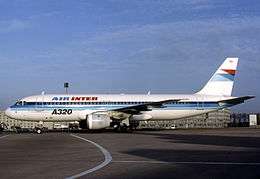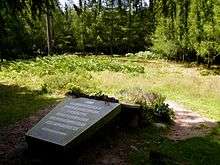Air Inter Flight 148
Air Inter Flight 148 was a scheduled passenger flight from Lyon–Saint-Exupéry Airport to Strasbourg Airport in France. On 20 January 1992, the aircraft operating the flight, an Airbus A320, crashed in the Vosges Mountains, France, near Mont Sainte-Odile, while circling to land at Strasbourg Airport. 87 of the 96 people on board were killed, while the remaining nine were all injured.[2][1]
 F-GGED, the aircraft involved in the accident, seen in January 1991 | |
| Accident | |
|---|---|
| Date | 20 January 1992 |
| Summary | Controlled flight into terrain due to ATC error and incorrect descent angle input by captain |
| Site | Barr, near Strasbourg Airport, Strasbourg, France[1] 48°25′31.638″N 007°24′18.3672″E |
| Aircraft | |
| Aircraft type | Airbus A320-111 |
| Operator | Air Inter |
| Registration | F-GGED |
| Flight origin | Lyon Satolas Airport |
| Destination | Strasbourg Airport |
| Occupants | 96 |
| Passengers | 90 |
| Crew | 6 |
| Fatalities | 87 |
| Injuries | 9 (5 serious, 4 minor) |
| Survivors | 9 |
Aircraft
The aircraft, an Airbus A320-111, registration F-GGED, serial number 15, first flew on 4 November 1988, and was delivered to Air Inter on 22 December 1988. At the time of the accident the aircraft had accumulated a total of 6,316 airframe hours.[3][4]
Accident
Flight 148, commanded by 42-year-old Captain Christian Hecquet and 37-year-old First Officer Joël Cherubin,[5] departed Satolas Airport in Lyon, France. While being vectored for a VOR/DME approach to runway 05 at Strasbourg, it crashed at 19:20:33 CET in the mountains at an altitude of 2,620 feet (800 m).[1]
The Bureau d'Enquêtes et d'Analyses pour la Sécurité de l'Aviation Civile (BEA) found that Flight 148 crashed because the pilots left the autopilot set in Vertical Speed Mode instead of Flight Path Angle Mode and then set "33" for "3.3° descent angle", resulting in a high descent rate of 3,300 feet (1,000 m) per minute into terrain.[1]
The pilots had no warning of the imminent impact because Air Inter had not equipped its aircraft with a ground proximity warning system (GPWS). It is speculated that this was because Air Inter – facing ferocious competition from France's TGV high-speed trains – may have encouraged its pilots to fly fast at low level (up to 350 knots (650 km/h; 400 mph) below 10,000 feet (3,000 m), while other airlines generally do not exceed 250 knots (460 km/h; 290 mph)), and GPWS systems gave too many nuisance warnings.[6]
The accident occurred at night, under low cloud and with light snow. Emergency response was slow and journalists were the first to find the crash site over four hours later.[7]
Aftermath

Accident investigators recommended 35 changes in their report. Airbus modified the interface of the autopilot so that a vertical speed setting would be displayed as a four-digit number, preventing confusion with the Flight Path Angle mode.[8] The flight data recorder was upgraded so that it was able to withstand higher temperatures and for longer.[6][1] The report also recommended that pilot training for the A320 should be enhanced and that ground proximity warning systems should be installed on them. Air Inter equipped its aircraft with ground proximity warning systems before the investigation was completed.[1][9][10]
Dramatization
The story of the disaster was featured on the ninth season of Cineflix television show Mayday in the episode entitled "The Final Blow" (also known as Air Crash Investigation as episode entitled "Crashed and Missing" or "Doomed to Fail" (S09E07)).[6]
See also
- Jean-Pierre Lecocq, a victim of the disaster
- Indian Airlines Flight 605, similar crash in India two years earlier
- Crossair Flight 3597, a similar CFIT crash caused by violating Minimum Safe Altitude
References
- "Rapport de la commission d'enquête sur l'accident survenu le 20 janvier 1992 près du Mont Sainte-Odile (Bas Rhin) à l'Airbus A 320 immatriculé F-GGED exploité par la compagnie Air Inter" [Report of the commission of inquiry into the accident on 20 January 1992 near Mont Sainte-Odile (Bas Rhin) to the Airbus A 320 registered F-GGED operated by Air Inter] (in French). Bureau d'Enquêtes et d'Analyses pour la Sécurité de l'Aviation Civile. Archived from the original on 14 August 2012. Retrieved 14 April 2010.
- Ranter, Harro. "ASN Aircraft accident Airbus A320-111 F-GGED Strasbourg-Entzheim Airport (SXB)". aviation-safety.net. Retrieved 1 November 2019.
- "OFFICIAL REPORT into the accident on 20 January 1992 near Mont Sainte-Odile (Bas-Rhin) of the AIRBUS A320 registered F-GGED operated by Air Inter" (PDF). aviation-safety.net. Bureau d'Enquêtes et d'Analyses pour la Sécurité de l'Aviation Civile. 26 November 1993. Retrieved 1 July 2019.
- "Air Inter F-GGED (Airbus A320 - MSN 15) | Airfleets aviation". www.airfleets.net. Retrieved 2 July 2019.
- "Quatorze ans après, les causes de la catastrophe du mont Sainte-Odile restent incertaines" [Fourteen years later, the causes of the Mont Sainte-Odile disaster remain uncertain]. Le Monde (in French). 2 May 2006. Retrieved 14 April 2010.
- "The Final Blow". Mayday. Season 9. 2010. Discovery Channel Canada / National Geographic Channel.
- List of Mayday episodes#Season 9 (2009)
- Johnson, Eric N.; Pritchett, Amy R. (March 1995). "DSpace@MIT: Experimental Study of Vertical Flight Path Mode Awareness". Dspace.mit.edu. Massachusetts Institute of Technology. Archived from the original on 21 May 2012. Retrieved 8 February 2014.
- Turner, Aimée (31 October 2006). "Air France CEO Jean-Cyril Spinetta defends rejection of GPWS equipment on Air Inter A320 fleet, despite fatal 1992 St Odile mountainside crash". Flightglobal.com. Flight International. Retrieved 1 November 2019.
- Wastnage, Justin (25 October 2006). "Video: January 1992 Air Inter Mt Saint Odile crash manslaughter verdict expected 7 November in Colmar". Flightglobal.com. Flight International. Retrieved 1 November 2019.
External links
| Wikimedia Commons has media related to Air Inter Flight 148. |
- Bureau d'Enquêtes et d'Analyses pour la Sécurité de l'Aviation Civile
- "RAPPORT de la commission d'enquête sur l'accident survenu le 20 janvier 1992 près du Mont Sainte-Odile (Bas Rhin) à l'Airbus A 320 immatriculé F-GGED exploité par la compagnie Air Inter. [REPORT of the Commission of Inquiry on into the accident on 20 January 1992 near Mont Sainte-Odile (Bas-Rhin) of the AIRBUS A320 registered F-GGED operated by the company Air Inter]" (in French) (Archive)
- PDF version (in French)
- Text version of final report at the University of Bielefeld (in French)
- CVR recording on YouTube